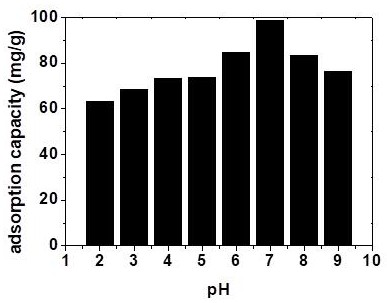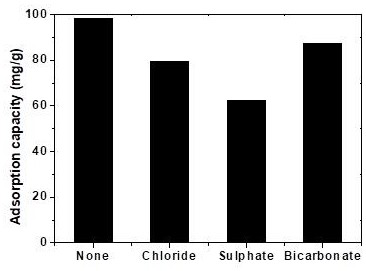Preparation method of adsorbent for removing nitrate in industrial wastewater
A technology for industrial wastewater and adsorbents, applied in chemical instruments and methods, water pollutants, water/sewage treatment, etc., can solve problems affecting nitrate adsorption and other issues
- Summary
- Abstract
- Description
- Claims
- Application Information
AI Technical Summary
Problems solved by technology
Method used
Image
Examples
preparation example Construction
[0031] A method for preparing an adsorbent for removing nitrates in industrial waste water, comprising the steps of:
[0032] Step 1: Mix 2-10g SiO 2 Soak mesoporous nanomaterials in 50-200ml 2%-10% acid for 5-12 hours, and SiO 2 Acid hydrolysis of mesoporous nanomaterials;
[0033] Step 2: Dissolve 2-10 g chitosan in 100-200ml deionized water or 2%-10% acid, and stir for 2-6 hours under magnetic stirring;
[0034] Step 3: The acidified SiO 2 Add to the above-mentioned chitosan solution, stir at room temperature for 4-8 hours, and suction filter the excess chitosan solution;
[0035] Step 4: Add 2-4 g of epichlorohydrin to the above-mentioned chitosan-functionalized mesoporous silica nanoparticles, add 1-5% KOH 20-100ml, and reflux at 60-100°C for 2-8 hours;
[0036] Step 5: Filter the polymer particles obtained in the above step 4 out of the suspension; add 2-10g of N,N,N',N'-tetraethyl-1,3-propylenediamine and 20-40g of ethanol dropwise to form The solution was stirred ...
Embodiment 1
[0042] Step 1: Add 2g SiO 2 (100 mesh) mesoporous nanomaterials were soaked in 100ml 2% acetic acid for 5 hours, acidified and hydrolyzed;
[0043] Step 2: Dissolve 2g chitosan (CS) in 100ml 2% acetic acid, and stir for 2 hours under magnetic stirring;
[0044]Step 3: The acidified SiO 2 Add in the above-mentioned chitosan solution, stir at room temperature for 4 hours, and suction filter the excess chitosan solution;
[0045] Step 4: Add 4 g of epichlorohydrin to the above-mentioned chitosan-functionalized mesoporous silica nanoparticles, add 20 ml of 1% KOH, and reflux at 60 ° C for 3 hours;
[0046] Step 5: The above polymer particles are filtered out of the suspension. Add a solution consisting of 4g N,N,N',N'-tetraethyl-1,3-propanediamine and 20g ethanol dropwise, and stir at 40°C for 2 h;
[0047] Step 6: After the reaction is completed, filter, alternately wash the obtained adsorbent with 1.0M HCI, then wash with deionized water to neutral pH, and dry in an oven at ...
Embodiment 2
[0049] Step 1: Add 3g SiO 2 (50 mesh) mesoporous nanomaterials were soaked in 100ml 3% hydrochloric acid for 5 hours, acidified and hydrolyzed;
[0050] Step 2: Dissolve 5 g of chitosan (CS) in 200 ml of deionized water, and stir for 2 hours under magnetic stirring;
[0051] Step 3: The acidified SiO 2 Add in the above-mentioned chitosan solution, stir at room temperature for 5 hours, and suction filter the excess chitosan solution;
[0052] Step 4: Add 3g of epichlorohydrin to the above-mentioned chitosan-functionalized mesoporous silica nanoparticles, add 20ml of 1% KOH, and reflux at 100°C for 2 hours;
[0053] Step 5: The above polymer particles are filtered out of the suspension. A solution consisting of 5g of N,N,N',N'-tetraethyl-1,3-propylenediamine and 30g of ethanol was added dropwise, and stirred at 60°C for 3h;
[0054] Step 6: After the reaction is completed, filter, alternately wash the obtained adsorbent with 1.5 M HCI, then wash with deionized water to neutr...
PUM
 Login to View More
Login to View More Abstract
Description
Claims
Application Information
 Login to View More
Login to View More - Generate Ideas
- Intellectual Property
- Life Sciences
- Materials
- Tech Scout
- Unparalleled Data Quality
- Higher Quality Content
- 60% Fewer Hallucinations
Browse by: Latest US Patents, China's latest patents, Technical Efficacy Thesaurus, Application Domain, Technology Topic, Popular Technical Reports.
© 2025 PatSnap. All rights reserved.Legal|Privacy policy|Modern Slavery Act Transparency Statement|Sitemap|About US| Contact US: help@patsnap.com



